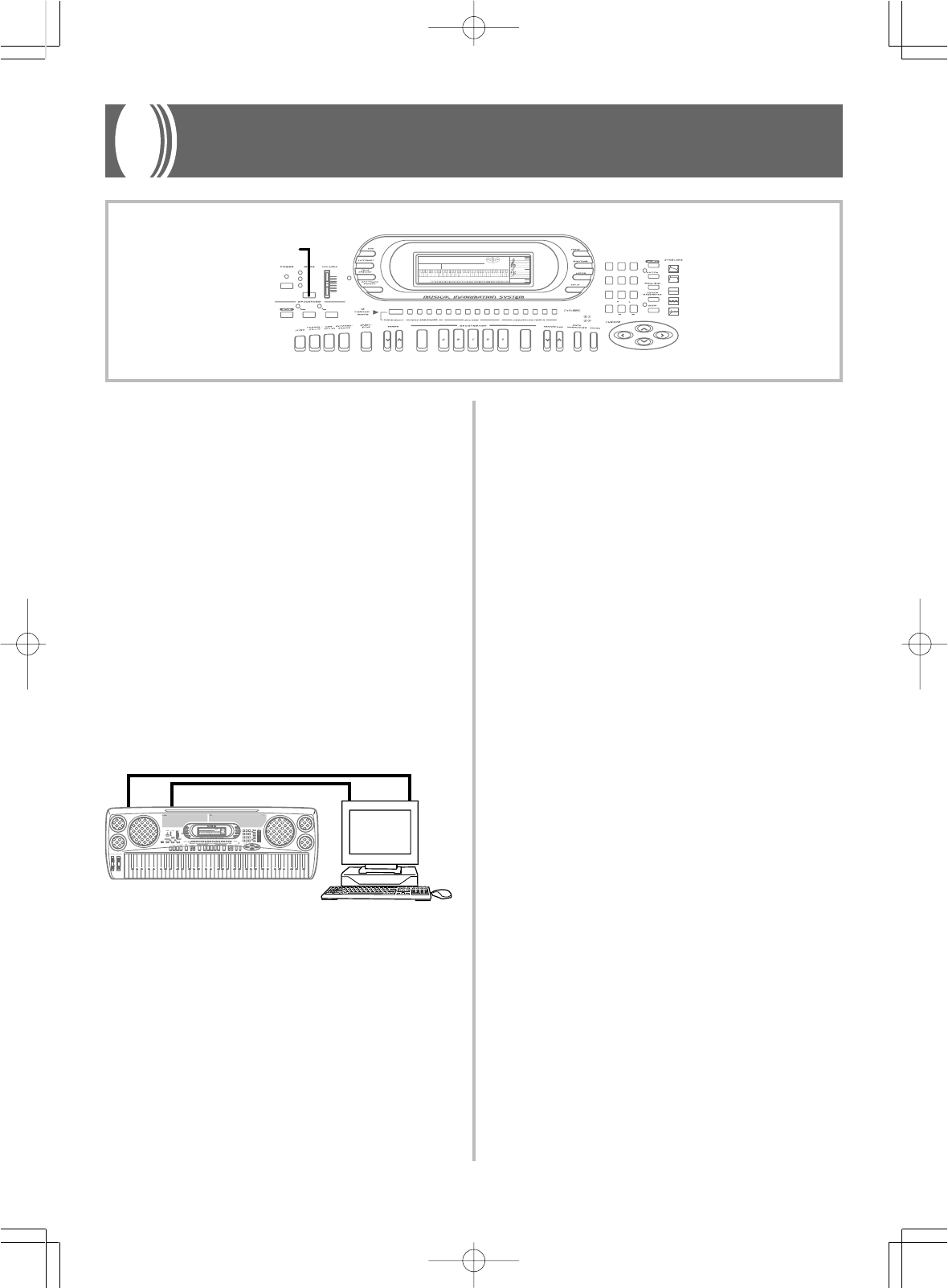
E-60
733A-E-062A
MIDI
What is MIDI?
The letters MIDI stand for Musical Instrument Digital Interface, which
is the name of a worldwide standard for digital signals and connec-
tors that makes it possible to exchange musical data between musi-
cal instruments and computers (machines) produced by different
manufacturers. MIDI compatible equipment can exchange keyboard
key press, key release, tone change, and other data as messages.
Though you do not need any special knowledge about MIDI to use
this keyboard as a stand-alone unit, MIDI operations require a bit of
specialized knowledge. This section provides you with an overview
of MIDI that will help to get you going.
MIDI Connections
MIDI messages are send out through the MIDI OUT terminal of one
machine to the MIDI IN terminal of another machine over a MIDI
cable. To send a message from this keyboard to another machine, for
example, you must use a MIDI cable to connect the MIDI OUT termi-
nal of this keyboard to the MIDI IN terminal of the other machine. To
send MIDI messages back to this keyboard, you need to use a MIDI
cable to connect the other machine’s MIDI OUT terminal to the MIDI
IN terminal of this keyboard.
To use a computer or other MIDI device to record and playback the
MIDI data produced by this keyboard, you must connect the MIDI
IN and MIDI OUT terminals of both machines in order send and re-
ceive data.
MIDI Channels
MIDI allows you to send the data for multiple parts at the same time,
with each part being sent over a separate MIDI channel. There are 16
MIDI channels, numbered 1 through 16, and MIDI channel data is
always included whenever you exchange data (key press, pedal op-
eration, etc.).
This keyboard is equipped with multi-timbre capabilities, which
means it can receive messages over all 16 MIDI channels and play up
to 16 parts at the same time.
Keyboard and pedal operations performed on this keyboard are sent
out by selecting a MIDI channel (1 to 16) and then sending the appro-
priate message.
General MIDI
As we have already seen, MIDI makes is possible to exchange musi-
cal data between devices produced by different manufacturers. This
musical data does not consist of the notes themselves, but rather in-
formation on whether a keyboard key is pressed or released, and the
tone number.
If tone number 1 on a keyboard produced by Company A is PIANO
while tone number 1 on a Company B's keyboard is BASS, for exam-
ple, sending data from Company A's keyboard to Company B's key-
board produces a result entirely different from the original. If a com-
puter, sequencer or other device with auto accompaniment capabili-
ties is used to produce music data for the Company A keyboard which
has 16 parts (16 channels) and then that data is sent to the Company
B keyboard which can receive only 10 parts (10 channels), the parts
that cannot be played will not be heard.
The standard for the tone numbering sequence, the number of parts,
and other general factors that determine the sound source configura-
tion, which was arrived at by mutual consultations by manufactur-
ers, is called General MIDI.
The General MIDI standard defines the tone numbering sequence,
the drum sound numbering sequence, the number of MIDI channels
that can be used, and other general factors that determine the sound
source configuration. Because of this, musical data produced on a
General MIDI sound source can be played back using similar tones
and identical nuances as the original, even when played on another
manufacturers sound source.
This keyboard conforms with General MIDI standards, so it can be
connected to a computer or other device and used to play back Gen-
eral MIDI data that has been purchased, downloaded from the Inter-
net, or obtained from any other source.
MIDI IN MIDI OUT
MIDI IN MIDI OUT
AMPENVELOPE
00 FLAT
01-17 VIBRATO
18-45 OTHERS
DECAY
SUSTAIN
PITCHENVELOPE
MIN
MAX
FULL RANGE
CHORD
CASIO CHORD
SONG
FINGERED
PATTERN
EXTERNAL
INTERNAL
UPPER1
CH 1
UPPER2
CH 2
LOWER1
CH 3
LOWER2
STOREBANK
CH 4
ACC VOL.
CH 5
CHORD1
CH 6
CHORD2
CH 7
CHORD3
CH 8
BASS
CH 9
RHYTHM
CH 10
TR1
CH 11
TR2
CH 12
TR3
CH 13
TR4
CH 14
TR5
CH 15
TR6
CH 16
789
456
1
0
23
PARAMETER RESET:
DELETE
/YESS/NO
MAIN MANU/
CHANNEL VOLUME:
SUB MANU/
CHANNEL SELECT:
Computer etc.
AMPENVELOPE
00 FLAT
01-17 VIBRATO
18-45 OTHERS
DECAY
SUSTAIN
PITCHENVELOPE
MIN
MAX
FULL RANGE
CHORD
CASIO CHORD
SONG
FINGERED
PATTERN
EXTERNAL
INTERNAL
UPPER1
CH 1
UPPER2
CH 2
LOWER1
CH 3
LOWER2
STOREBANK
CH 4
ACC VOL.
CH 5
CHORD1
CH 6
CHORD2
CH 7
CHORD3
CH 8
BASS
CH 9
RHYTHM
CH 10
TR1
CH 11
TR2
CH 12
TR3
CH 13
TR4
CH 14
TR5
CH 15
TR6
CH 16
789
456
1
0
23
PARAMETER RESET:
DELETE
/YESS/NO
MAIN MANU/
CHANNEL VOLUME:
SUB MANU/
CHANNEL SELECT:
WK-1800/1600(E)-60~66 03.7.31, 5:22 PMPage 60 Adobe PageMaker 6.5J/PPC


















